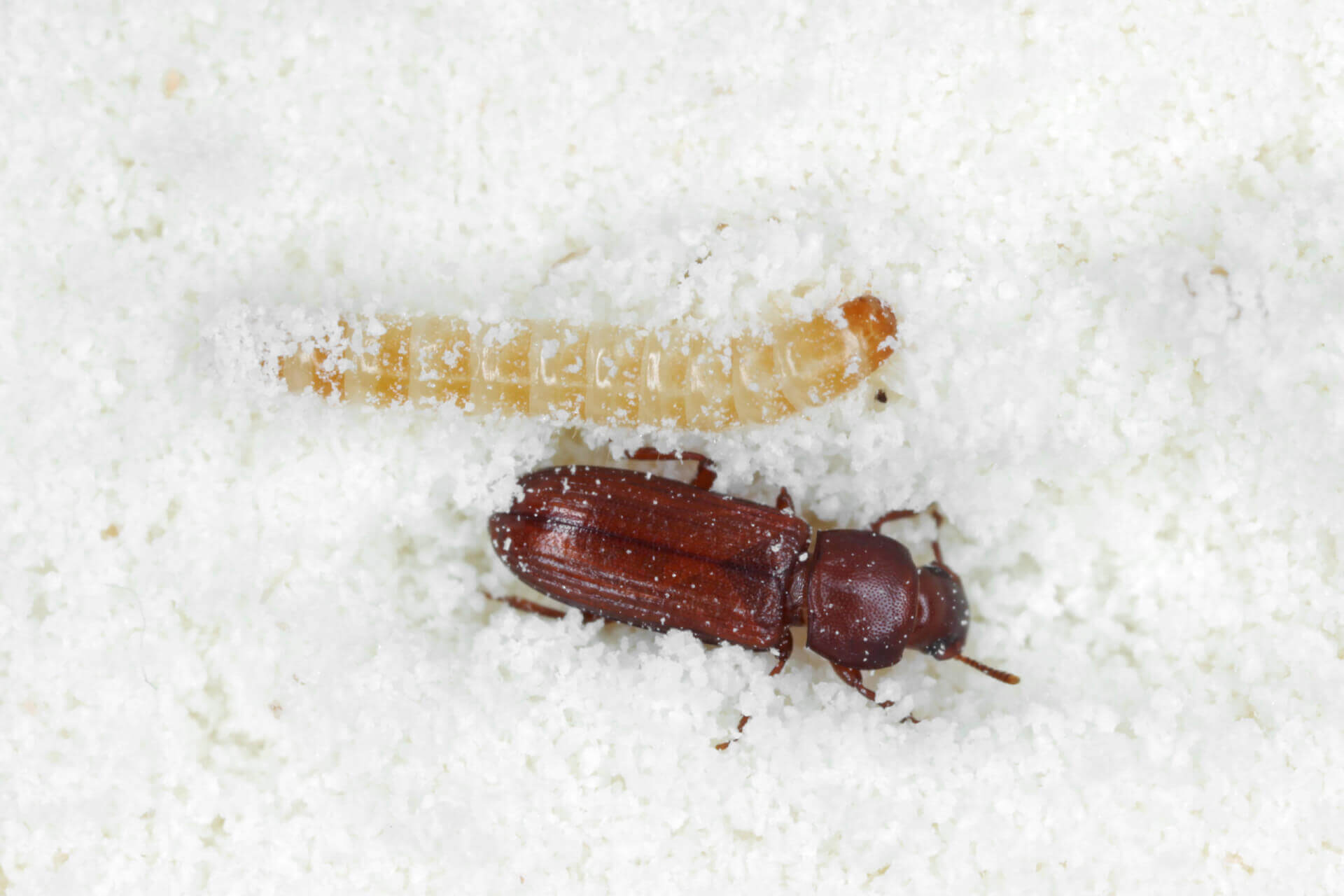Confused Flour Beetle Facts & Information
Everything you need to know about confused flour beetles
what do Confused Flour Beetles look like

Confused flour beetles are shiny reddish-brown in color, winged, and grow to be about 1/8th of an inch in length. Their head and the upper parts of their thorax are heavily covered with tiny punctures, their wing covers are ridged end-to-end, and their antennae widen out gradually from the base. They are often mistaken for the red flour beetle. Don’t let them fool you, though.
The average lifespan of an adult flour beetle is about one year. Females lay about 450 sticky, white eggs directly onto a food source. This tacky exterior of the eggs collects fine particles and broken grain, which coats and protects them until they hatch. Larvae then feed on the surrounding food until pupating and emerging as adults.
Both the red and confused flour beetles infest grain and grain products worldwide. They are commonly found in stored grains within mills, warehouses, supermarkets, and homes. In homes, these pests can thrive in crevices inside pantries and kitchen cabinets where food spills will sustain them quite happily. Confused flour beetles feed on finely milled starches such as flour or meal. They do not feed on whole or undamaged kernels and need ground grain to survive. While they are both flour beetles, they’re different species and should be properly treated. That’s why a Board Certified Entomologist is needed to properly identify the beetle you have to make sure the correct beetles treatments are being used.Not the beetle you have?
The average lifespan of an adult flour beetle is about one year. Females lay about 450 sticky, white eggs directly onto a food source. This tacky exterior of the eggs collects fine particles and broken grain, which coats and protects them until they hatch. Larvae then feed on the surrounding food until pupating and emerging as adults.
Both the red and confused flour beetles infest grain and grain products worldwide. They are commonly found in stored grains within mills, warehouses, supermarkets, and homes. In homes, these pests can thrive in crevices inside pantries and kitchen cabinets where food spills will sustain them quite happily. Confused flour beetles feed on finely milled starches such as flour or meal. They do not feed on whole or undamaged kernels and need ground grain to survive. While they are both flour beetles, they’re different species and should be properly treated. That’s why a Board Certified Entomologist is needed to properly identify the beetle you have to make sure the correct beetles treatments are being used.Not the beetle you have?
how did i get confused flour beetles
Unfortunately, confused flour beetles usually come from infested food right off the grocery store shelf. It’s not anything you’re doing at your business or home. If flour beetles have found their way into your pantry, then the first step is to throw away any infested food and perform a deep cleaning. Dispose of any food that may have been contaminated first. Then take all the remaining uncontaminated items out of your cabinets or pantry so you can deep clean the shelves. If you have shelf liner, throw it away and clean where it was. Don’t forget to vacuum the cracks behind your molding. It only takes a few grains of food to attract a population of confused flour beetles. Once everything is clean and you’re ready to restock, store food in tightly sealed containers made of glass or hard plastic. Note the brand of food you purchased that was infested and let your local grocery store know. And of course avoid that brand in the future.
where do confused flour beetles live
Flour beetles survive through cold winters in warm granaries, farms, mills, warehouses, supermarkets, and even in homes, where they can find the ground grain they need to survive. They only eat finely milled starches like flour and meal, and do not feed on whole kernels. In homes, flour beetles thrive in crevices inside pantries and cabinets, where food spills infiltrate. Female flour beetles like to lay about 450 sticky, white eggs directly onto a food source, on which the larvae can feast when they hatch. So, if there’s the correct conditions with the correct food sources, they will live there. If there’s product that is infested with confused flour beetles, they will travel with that product to the food processing plant, into the packaging, into your shopping cart, and ultimately into your pantry. So they basically live wherever their food source is.
what Problems do confused flour beetles cause
In nature, these beetles are not pests. But in your pantry and food storage areas, they eat many different types of dried food. Large numbers of confused flour beetles will mean a large number of dead bodies, cast skins, fecal pellets, and the liquids they expel which can give grain and other foods they infest an extremely pungent odor. Nobody wants to eat that grain and you certainly don’t want to send it to a vendor! Bring in a professional beetle exterminator to get ultimate beetle control.
how do i prevent confused flour beetles
In nature, confused flour beetles are not pests. They are the most destructive to food processing plants, grain farmers, and homeowners when they unwittingly bring in an infested package of food. The beetles do cause damage by feeding but probably cause more problems by contaminating the grain. Large numbers of dead bodies, cast skins, and fecal pellets, as well as liquids (quinones), can produce extremely pungent odors in grain. The nauseous smell and taste caused by infestations of confused and red flour beetles can result in poor feed consumption by livestock and rejection by grain buyers.
In most cases, the presence of live insects in a grain bin indicates that moisture buildup and molds are also present. The combination of these three factors can greatly reduce the quality and value of grain. Homes and businesses alike need a beetle exterminator to perform the correct confused flour beetle treatments and achieve ultimate beetle control.
In most cases, the presence of live insects in a grain bin indicates that moisture buildup and molds are also present. The combination of these three factors can greatly reduce the quality and value of grain. Homes and businesses alike need a beetle exterminator to perform the correct confused flour beetle treatments and achieve ultimate beetle control.
WHY WESTERN for confused flour beetle control
We’re passionate about controlling beetles in your home or business because we live and work here – it’s our neighborhood, too. With our almost 100 years of experience keeping homes and businesses in Connecticut, Delaware, New Jersey, New York, and Pennsylvania safe from pests, Western has the experience you can trust.
100% Satisfaction Guarantee
24-Hour Guaranteed Response
Board Certified Entomologists
Say goodbye to confused flour beetles.
GET MY QUOTE
